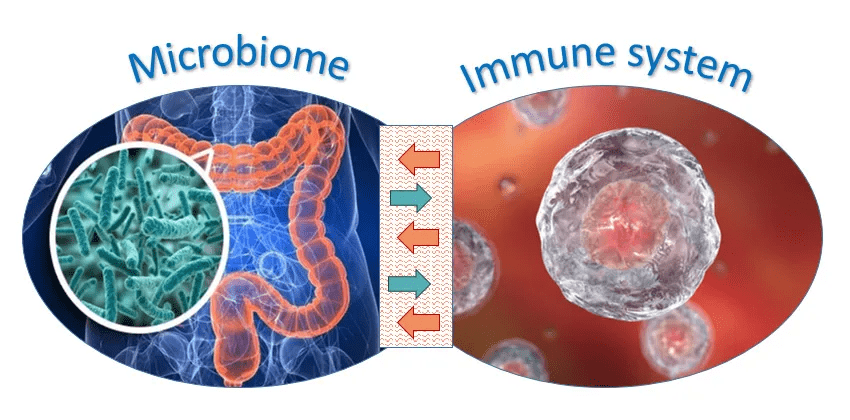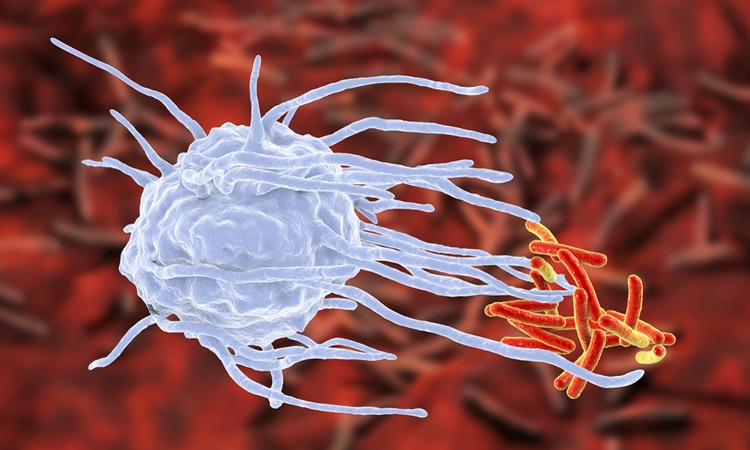
The digestive tract is an estimated 16-foot long system, which includes the upper digestive tract (oral cavity, esophagus, stomach) in addition to the lower digestive tract (small and large intestine) and accessory organs (pancreas, liver, gallbladder) (Gropper, Smith, & Carr, 2018). Residing within the lower digestive tract is a complex system of bacteria, fungi, viruses, and parasites which coalesce to form the microbiota (Kamada & Nunez, 2014). Such an ecosystem of microorganisms plays several roles in maintaining homeostasis such as metabolism of nutrients (i.e., fermentation, synthesizing vitamins), immune system development/regulation, and clearance of pathogens (Kamada & Nunez, 2014). The following sections will explore the immune system in greater detail, and its relationship to the microbiota.

Within the lining of the intestine, known as the mucosa and sub-mucosa, exists lymphoid tissue which contains macrophages (i.e., engulfs and digests pathogens/cellular debris) and lymphocytes (i.e., make anti-bodies and helps kill tumor cells) (Gropper et al., 2018). Furthermore, said lymphoid tissue has cells (plasma) which produce IgA that fuses to antigens ingested in foods, helps inhibit proliferation of pathogenic bacteria, and inhibits bacterial movement (Gropper et al., 2018). M-cells transport antigens towards lymphocytes enabling an immune response in addition to dendritic cells, which also bestows antigens to the immune system after destruction (Gropper et al., 2018). Having briefly considered constituents of the immune system, the following will explore the relationship of the immune system and microbiota in greater detail.
Of particular interest is the symbiotic relationship between the immune system and resident bacteria; the microbiota plays a critical role in the function/development of the immune system, while the immune system regulates the function/composition of the microbiota (Kamada & Nunez, 2014). Such knowledge helps provide clarity as to the positioning of 70% immune system and microbiota in close proximity (i.e., provides the opportunity for critical interactions) (Lopetuso, Scaldaferri, Bruno, Petito, Franceschi, & Gasbarrini, 2015). A larger partitioning of immune system resources within the gut might also be due to the very nature of the GI system itself; the intestinal tract is an entry point from the outside world to the fragile inner workings of the body (Lopetuso et al., 2015). As such, the epithelium of GI tract is a potential gateway for both nutrients (and pathogens), demanding layers of defense to include the immune system and gut flora.
In conclusion, the immune system and microbiota serve one another to achieve and maintain their respective functions. Although each system can have distinct and similar roles, they share a symbiotic relationship that ultimately benefits the host. As such, it is imperative that such a relationship remain optimal and in balance to maintain the long-term health of the immune system, microbiota, and the individual.
References
Gropper, S. S., Smith, J. L., & Carr, T. P. (2018). Advanced nutrition and human metabolism(7thed.). Boston, MA: Cengage Learning.
Kamada, N., & Nunez, G. (2014). Regulation of the immune system by resident intestinal bacteria. Gastroenterology, 146(6), 1477-1488.
Lopetuso, L. R., Scaldaferri, F., Bruno, G., Petito, V., Franceschi, F., & Gasbarrini, A. (2015). The therapeutic management of gut barrier leaking: the emerging role for mucosal barrier protectors. European Review for Medical and Pharmacological Sciences, 19(6), 1068-1076.
-Michael McIsaac
